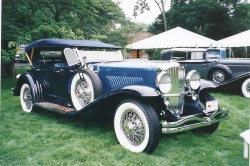 1929 Duesenberg Model J. Click image to enlarge |
Article and photo by Bill Vance
Among the thousands of automobile nameplates throughout history, America’s Duesenberg J and SJ ranked with the world’s best. They were the equal of such legendary marques as England’s Rolls-Royce, Germany’s Mercedes-Benz, France’s Bugatti, Italy’s Isotta-Fraschini and Spain’s Hispano-Suiza.
The J and SJ were the creation of German-born Fred and August Duesenberg, who came to America as children in the late 1800s. Growing up in Iowa, they were keen cyclists with enough natural mechanical talent to build their own race-winning bicycles.
With the emergence of motorized vehicles, the brothers were soon dabbling in motorcycles and cars. In 1906, with backing from a Des Moines lawyer named Mason, they began production of the Mason car, a good performer that won hill climbs and races. The company prospered and in 1910 was bought out by the Maytag Company, better known for washing machines than for cars.
By 1913 the Duesenbergs were able to organize their own Duesenberg Motor Company in St. Paul, Minnesota, to build automobile and marine engines. They were soon producing successful racing cars that were made famous by such legendary driving greats as Eddie Rickenbacker and Ralph Mulford.
This attracted New York capital and in 1916, a $1.5 million venture was organized and a huge factory constructed for the Duesenberg Motors Corp. in Elizabeth, New Jersey. This was during the First World War, and car building was delayed while the plant turned out aero engines.
When the war ended in 1918 the brothers returned to the car-building venture with a four-cylinder engine, but their hearts weren’t really in it. This led to their departure, leaving them free to concentrate on their real love, an eight-cylinder overhead camshaft racing engine.
By the early 1920s they were back in business as the Duesenberg Automobile and Motor Corp. in Indianapolis, Indiana. They built some 600 Model A Duesenbergs, powered by a detuned version of their straight-eight racing engine, but these were not profitable. The Duesenbergs proved to be better engineers than they were businessmen.
Then, in 1926, events evolved that would establish the Duesenberg name at the pinnacle of the automotive world. Errett Lobban Cord, president of the Auburn Automobile Co. in Auburn, Indiana, bought the Duesenberg company and asked the brothers to design a mighty motorcar that would match the world’s finest marques.








